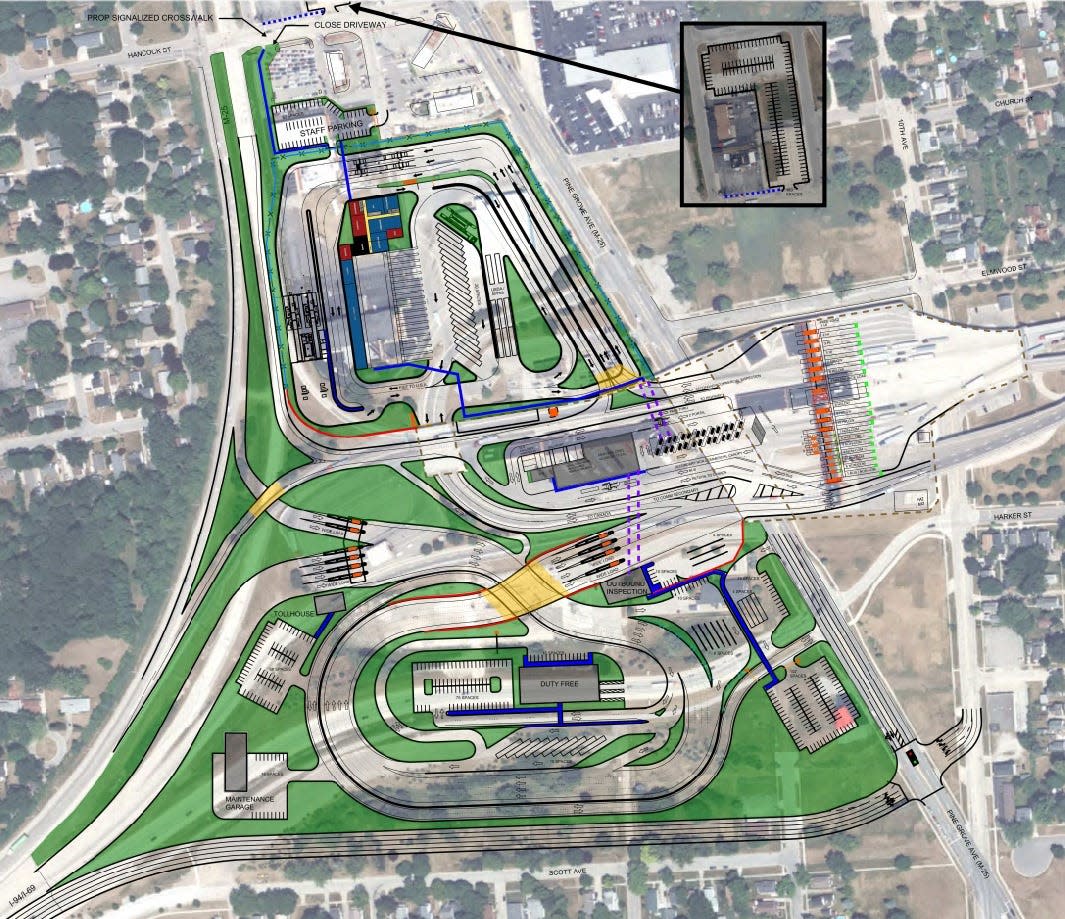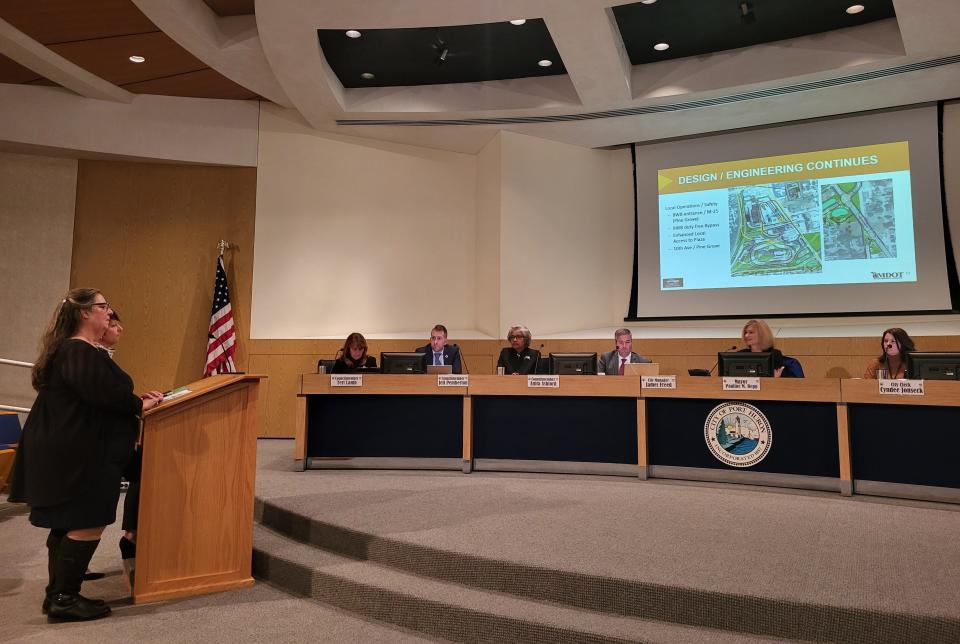Port Huron officials get look at draft plans for Blue Water Bridge Plaza expansion

Michigan Department of Transportation officials pledged transparency to Port Huron officials this week and intent to address concerns related to updated plans to expand the Blue Water Bridge Plaza.
But they also emphasized those details are still in flux while they work to finalize a host of details — notably, how to cover the skyrocketing cost in a narrowed design and a construction timeline for the project.
“Neither Carrie or I were here when there were other versions of this project,” Amy Winn, bridge administrator, told City Council members on Monday. “And we’ve worked really hard to try and educate ourselves about what went right and what went wrong.”
Winn, Carrie Warren, the plaza project manager, and several other MDOT officials and consultants gave a presentation to city officials and fielded questions for more than an hour and a half at the meeting. It came just weeks after the city expressed concern over changes made this year to the scope in the layout of a plaza project since the last officially green-lit plan in 2009.
The latest draft proposes constructing some new facilities for U.S. Customs and Border Patrol to address changes in federal requirements, relocating duty-free south of the bridge, splitting the intersection at Pine Grove and 10th avenues, and installing an entrance loop to the bridge along the Scott Avenue neighborhood.
It was the latter that prompted the most pushback from city officials this fall, requesting MDOT take an additional look at environmental and other impacts.
Warren said this week they were open to future studies, though she and Winn also reiterated a need to address public involvement first.
And after long-term loss in tax revenue from the property MDOT acquired in the 2000s for the expansion, some council members reiterated concerns about how information has been shared — with Mayor Pro Tem Sherry Archibald adding, “Forgive me if I’m somewhat skeptical.”

However, Winn and Warren said they’re hoping to do things differently moving forward and want to clear up what they referred to as miscommunications over the still-evolving and unfinalized project design.
“This is our first step in doing things differently,” Winn said. “This is a feasibility study, and what we’re trying to accomplish is transparency and coming in early saying, ‘This is what we looked at, this is what it’s looking like, but what are your concerns?’ That is different, in my opinion, than coming in afterward.”
A draft feasibility study was expected to be completed in December and public input to start in January.
Warren said they’re currently in a re-evaluation process for the project and under “a tight timeline” to begin construction in a year, meeting requirements of a $25 million federal grant received in 2020.
Despite the commitment expressed Monday, MDOT officials said there remained things that wouldn't be determined until later over the next several years — even after construction begins.
And that includes exactly how the state agency will pay for a total expansion project in three phases with a cost that’s risen in estimation from the $350 million range to the $600 million range in the last two years.
What did City Council learn?
The feasibility process for a reconfigured bridge expansion comes as the Blue Water Bridge’s truck traffic begins to return to levels from before COVID-19 shutdowns.
From 2017 to 2019, she said the bridge averaged 4.6 million crossings. During the pandemic, it averaged 2 million. Then, in the first quarter of this year, it reached 1.1 million crossings.
“Which supports traffic is returning to pre-pandemic averages,” Winn said. “As I mentioned earlier, our current truck traffic has increased by 6%, and what the plaza expansion ensures is the vitality of the Blue Water Bridge and eliminates some of the crucial safety concerns that we have.”
While some of the past plaza expansion concepts called for using existing facilities, the draft redesign this year calls for a series of new buildings and the demolition of the existing ones.
According to state consultants and officials, the more consolidated layout in the 2022 draft still falls within the same footprint as the 2009 plan, though the difference in total property coverage is 109 versus 82 acres.
That does not include five acres just north of the project where MDOT is working with DTE Energy to relocate and build a new substation — a $35 million contribution from MDOT that Winn called “unprecedented” to benefit the surrounding community as well as benefit the new plaza’s operations.
City Manager James Freed said they were concerned with the density issue of the substation, as it wasn’t factored in the original environmental impact studies in 2009, adding, “It does make noise. It is significant.”
On the traffic loop, MDOT officials showed early renderings of adding an aesthetic wall to and slightly enhance greenspace along Scott Avenue — there’s also a non-motorized path through the area — but Freed and some council members still expressed ire for how it’d impact the nearby neighborhood.
Multiple city officials questioned the potential noise if there are truck backups and whether they’d wait to cross the bridge.
“We can hear engine breaking from my place already,” said Councilman Bob Mosurak. “I can’t imagine how loud this is going to be for the (neighbors who live closer).”
Warren said they’re still vetting data related to the re-evaluation process, including for noise and air quality, adding, “If that data reveals a need to go further” than the original 2009 environmental study, “we will go further.” Still, she admitted significant changes could hold up the start of the project 18 to 24 months.
In addition to the loop, the 2022 plan separates traffic currently crossing at the Pine Grove and 10th Avenue intersection.
According to MDOT maps, the plaza reconstruction would cut off northbound traffic on 10th at Pine Grove, preventing cars crossing the state throughway — instead picking 10th back up where interstate traffic exits the highway before the bridge across Pine Grove.
“You’re at a signal either way. So, why not make it a safe intersection?” said Linda Burchell, MDOT’s manager of the Bay Region transportation service center. “The skewed intersection, you have the strange turning movements, you’ve got people crossing into weird lanes that don’t exist, and things like that. A T’d-in intersection, where you can see from both directions, is 9,000% more safe. … I think this best serves the majority of the motoring public.”
All those major proposed changes, Warren said, eliminate safety concerns about truck traffic coming off the highway to go to the duty-free via Pine Grove and dangerous traffic weaving toward the bridge and decreases commuter congestion and truck backups overall.
She put the ideal construction timeline for all three phases of the project at eight to 10 years, giving them time to address the second and third phases, which require acquiring property where a local hotel and bowling alley are located north of the bridge.
The first phase, Winn said, is entirely encompassed south of the bridge where MDOT already owns the property, and it includes the relocation of duty-free and the entrance loop around it.
Winn said except for the $25 million federal grant, MDOT is covering most of the cost of the project itself, citing the CBP’s lack of funding for the expansion.
MDOT officials have said they did plan to borrow funds for much of the cost via issuing bonds, as well as bridge revenues. On Monday, Winn said, “Obviously we do not have 600 million, nor can we afford to bond” the whole project, admitting covering the cost would take time.
Contact Jackie Smith at (810) 989-6270 or jssmith@gannett.com. Follow her on Twitter @Jackie20Smtih.

This article originally appeared on Port Huron Times Herald: Port Huron officials get look at draft plans for Blue Water Bridge Plaza expansion

